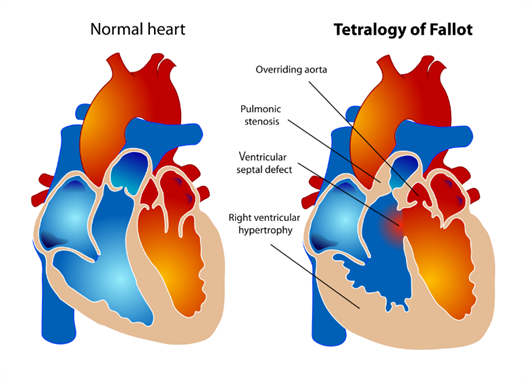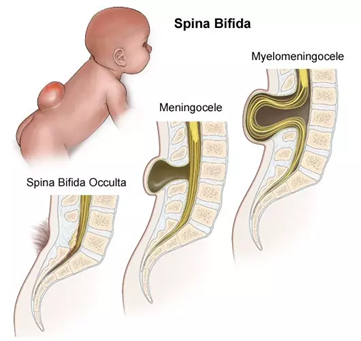A nurse is caring for an infant who has Tetralogy of Fallot and notes that the infant is easily fatigued when eating. Which defect is not present in this cardiac congenital malformation?
Overriding aorta
Pulmonary stenosis
Left ventricular hypertrophy
Ventricular septal defect
The Correct Answer is C
A. Overriding aorta: In Tetralogy of Fallot, the aorta is positioned over the ventricular septal defect (VSD), rather than solely over the left ventricle as it would be in a normal heart. This is called overriding aorta, which allows blood from both the right and left ventricles to enter the aorta.
B. Pulmonary stenosis: This is a critical component of Tetralogy of Fallot. Pulmonary stenosis refers to narrowing of the pulmonary valve or the area just below it, which restricts blood flow from the right ventricle to the pulmonary artery. This results in decreased blood flow to the lungs for oxygenation.
C. Left ventricular hypertrophy: This choice is not typically associated with Tetralogy of Fallot. Left ventricular hypertrophy refers to an enlargement or thickening of the muscular wall of the left ventricle of the heart. It is often seen in conditions where the left ventricle has to work harder to pump blood, such as in hypertension or aortic stenosis, but it is not a characteristic feature of Tetralogy of Fallot.
D. Ventricular septal defect: This defect is one of the four components of Tetralogy of Fallot. A ventricular septal defect (VSD) is a hole in the septum, the muscular wall that separates the left and right ventricles of the heart. In Tetralogy of Fallot, the VSD allows oxygen-poor blood from the right ventricle to flow directly into the left ventricle and out to the body.

Nursing Test Bank
Naxlex Comprehensive Predictor Exams
Related Questions
Correct Answer is D
Explanation
A. Promote maternal-infant bonding: While promoting maternal-infant bonding is essential for the overall well-being of the newborn and family, it may not be the priority in this situation. The immediate focus is on medical management and preventing complications associated with the myelomeningocele.
B. Provide age-appropriate stimulation: Age-appropriate stimulation is important for newborn development, but in the case of a newborn with a myelomeningocele awaiting surgery, the priority is to minimize any potential risk of injury or infection to the exposed neural tissue.
C. Educate the parents about the defect: Education about the myelomeningocele and its long-term implications is crucial for the parents' understanding and ability to care for their child. However, while important, this may not be the priority at the immediate moment.
D. Maintain integrity of the sac: This is the priority nursing goal in caring for a newborn with a myelomeningocele awaiting surgery. The sac covering the exposed neural tissue must be carefully protected to prevent infection and further damage. Measures such as keeping the sac moist with sterile saline dressings and preventing trauma to the area are essential to maintain its integrity.

Correct Answer is B
Explanation
A. "When I use this technique the medication will not run out of the ear."
This explanation is not entirely accurate. While pulling the auricle down and back may help prevent ear drops from immediately dripping out of the ear, the primary purpose of this technique is to straighten the ear canal, facilitating the passage of the medication into the inner ear region for optimal effectiveness. The prevention of medication runoff is a secondary benefit.
B. “This opens the ear canal, allowing medication to reach the inner ear region.”
This explanation is correct. Pulling the auricle down and back helps to straighten the ear canal, making it easier for the ear drops to enter the ear canal and reach the inner ear where they can effectively treat the condition. This is the main purpose of using this technique.
C. “This is the safest and easiest way to administer this medication.”
While pulling the auricle down and back is a commonly used technique for administering ear drops, describing it as the safest and easiest way may not fully capture its purpose. Safety and ease of administration are important considerations, but the primary rationale for this technique is to facilitate the delivery of medication to the inner ear.
D. “When I use the technique, your child experiences less pain.”
This explanation is inaccurate. Pulling the auricle down and back may not directly reduce pain. The main purpose of this technique is to ensure that the medication reaches the inner ear region for effective treatment. While discomfort during administration may be minimized with proper technique, the primary focus is on medication delivery rather than pain reduction.
Whether you are a student looking to ace your exams or a practicing nurse seeking to enhance your expertise , our nursing education contents will empower you with the confidence and competence to make a difference in the lives of patients and become a respected leader in the healthcare field.
Visit Naxlex, invest in your future and unlock endless possibilities with our unparalleled nursing education contents today
Report Wrong Answer on the Current Question
Do you disagree with the answer? If yes, what is your expected answer? Explain.
Kindly be descriptive with the issue you are facing.
